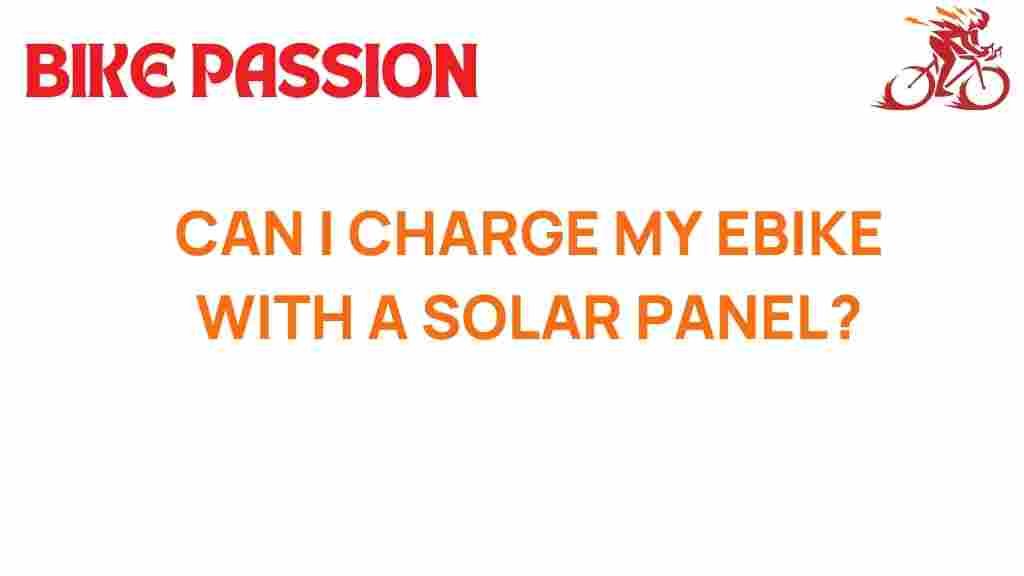Powering Your Ride: Can You Charge an E-Bike with Solar Energy?
As the popularity of electric bikes, or e-bikes, continues to grow, many cyclists are exploring innovative ways to power their rides sustainably. One of the most exciting options is harnessing solar energy through solar panels. This method not only enhances the eco-friendliness of your outdoor adventures but also aligns perfectly with the principles of renewable energy and green technology. In this article, we will explore whether you can charge an e-bike with solar energy and delve deeper into the various charging options available.
Understanding E-Bikes and Solar Energy
E-bikes are designed for ease of use, providing an electric motor to assist with pedaling, making cycling more accessible for everyone. They are powered by rechargeable batteries, and charging these batteries typically requires access to electricity. Solar energy, on the other hand, is a clean and renewable energy source that can be harnessed using solar panels. Combining these two technologies offers a promising solution for sustainable transportation.
The Benefits of Using Solar Panels for E-Bike Charging
- Sustainability: Charging your e-bike with solar energy reduces your carbon footprint.
- Cost Savings: Once installed, solar panels can significantly lower your electricity costs.
- Convenience: Solar charging can be done virtually anywhere, provided there is sunlight.
- Eco-Friendly: Using renewable energy reflects a commitment to environmentally friendly practices.
Charging Options: How to Charge Your E-Bike with Solar Energy
Charging your e-bike with solar energy is entirely feasible, but it requires the right setup. Below are the steps you need to follow to charge your e-bike using solar panels:
1. Choose the Right Solar Panel
When considering solar energy for your e-bike, the first step is selecting an appropriate solar panel. Here are some key factors to consider:
- Power Output: Look for a solar panel that produces enough wattage to charge your e-bike battery effectively. Most e-bike batteries range from 250W to 750W.
- Portability: If you plan on using solar panels for outdoor adventures, choose lightweight and foldable solar panels for easy transport.
- Durability: Ensure the solar panels are weather-resistant and can withstand outdoor conditions.
2. Invest in a Solar Charge Controller
A solar charge controller is crucial for regulating the voltage and current coming from the solar panels to the e-bike battery. This device helps prevent overcharging, ensuring your battery remains safe while charging. Look for a charge controller compatible with your e-bike’s battery voltage.
3. Set Up Your Solar Charging System
Once you have your solar panel and charge controller, it’s time to set up your solar charging system:
- Connect the Solar Panel: Attach the solar panel to the charge controller using the appropriate cables.
- Connect to the E-Bike Battery: Use the output of the solar charge controller to connect to the e-bike battery.
- Position the Solar Panel: Ensure the solar panel is placed in direct sunlight for optimal charging performance.
4. Monitor Charging Progress
Many solar charge controllers come equipped with LCD displays that provide real-time data on charging status. Monitor the progress to ensure the battery is charging properly.
5. Enjoy Your Ride!
Once your e-bike is charged, you can enjoy the benefits of sustainable transportation. With your e-bike powered by renewable energy, you can explore the outdoors confidently, knowing you are contributing to a greener planet.
Troubleshooting Tips for Solar Charging
While charging your e-bike with solar energy is generally straightforward, you may encounter some issues. Here are some common problems and their solutions:
1. Insufficient Power Output
If your solar panel isn’t producing enough power:
- Check if the panel is positioned correctly to receive maximum sunlight.
- Inspect the connections for any loose or damaged wires.
- Ensure the solar panel is clean and free of debris.
2. Overcharging or Undercharging
To prevent battery damage:
- Use a reliable solar charge controller to regulate the charging process.
- Regularly check the battery voltage and health.
3. Weather Conditions
Cloudy or rainy weather can affect solar charging:
- Have a backup charging option, such as a standard electrical outlet, in case of prolonged cloudy weather.
- Consider using a higher wattage solar panel for better performance in low-light conditions.
Conclusion
Charging your e-bike with solar energy is not only possible but also a fantastic way to embrace sustainability and eco-friendly practices. With the right solar panel, charge controller, and setup, you can enjoy the freedom of outdoor adventures while contributing to a cleaner environment. Explore the innovative possibilities of renewable energy and consider integrating solar charging into your e-bike experience. For more related tips on sustainable practices, check out this helpful resource.
By making the switch to solar energy for your e-bike, you are not only enhancing your cycling experience but also becoming a part of the growing movement towards green technology. So, equip yourself with the right tools and ride into a sustainable future!
This article is in the category Tech and created by BikePassion Team
